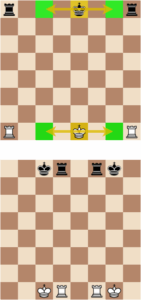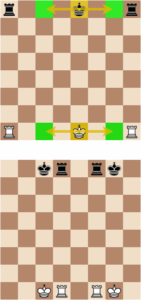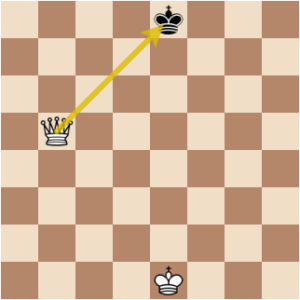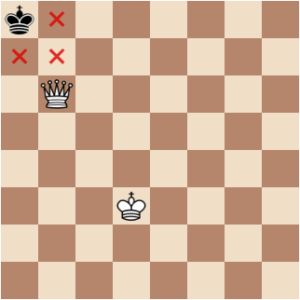Table of Contents
1. Introduction to Chess
Chess is an ancient game of strategy that involves two players competing on a board with 64 alternating dark and light squares. Renowned for its depth and complexity, chess has its roots in India, dating back to around the 6th century, and took its modern shape in Europe during the 15th century. The game’s objective is to place your opponent’s king in a situation where it inevitably faces capture, a scenario known as “checkmate.” While newcomers may find chess daunting, it can also be a rewarding and enjoyable endeavor. Playing chess boosts critical thinking, enhances problem-solving skills, and fosters patience.
2. Understanding the Chessboard Setup
The chessboard features 64 squares of alternating light and dark colors, arranged in an 8×8 grid. These squares form eight vertical columns, referred to as files (labeled a through h), and eight horizontal rows, known as ranks (numbered 1 through 8). Correctly orienting the board is essential: the light-colored square must be in the bottom-right corner for both players.
Every player starts with 16 pieces, which are placed on the two ranks closest to them. The second rank (row 2 for White, row 7 for Black) is entirely occupied by pawns. The first rank (row 1 for White, row 8 for Black) contains the more powerful pieces arranged in a mirrored layout:
Rook – Knight – Bishop – Queen – King – Bishop – Knight – Rook.
A useful tip: “Queen on her color.” This means the white queen should be on a white square, and the black queen on a black square—this simple rule ensures correct placement every time.
3. Chess Pieces and Their Movements
Each type of piece moves in a specific way. Understanding these movements is crucial for playing effectively.
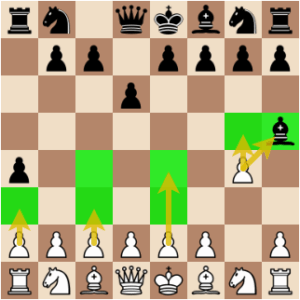
Pawn
– Moves one square forward but captures one square diagonally.
– On its first move, a pawn may advance two squares.
– Cannot move backward.
– Can promote to another piece (except a king) upon reaching the opponent’s back rank.
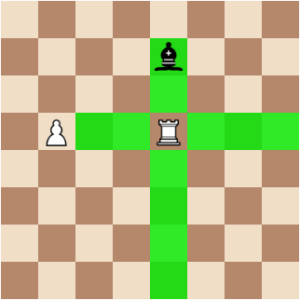
Rook
– Moves any number of squares horizontally or vertically.
– Cannot jump over other pieces.
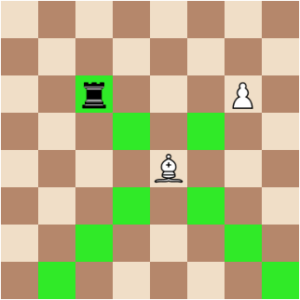
Knight
– Moves in an L-shape: two squares in one direction, followed by one square at a right angle.
– Can jump over other pieces, making it the only one.

Bishop
– Moves diagonally any number of squares.
– Stays on the same color square for the entire game.
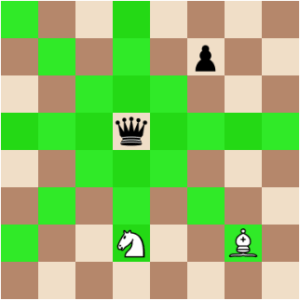
Queen
– Moves in any direction: vertically, horizontally, or diagonally, any number of squares.
– Considered the most powerful piece.
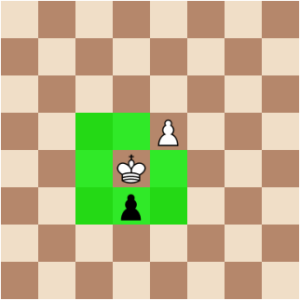
King
– Moves one square in any direction.
– Cannot move into check (a threatened square).
4. Fundamental Rules of Chess
- White always moves first: The player controlling the white pieces makes the first move, starting the game.
- Players alternate turns: Each player takes one turn to move a piece, alternating between them throughout the game.
- You cannot move a piece to a square occupied by one of your own: Players cannot place their pieces on squares already occupied by their pieces.
- Capturing is done by moving your piece to the square occupied by an opponent’s piece. To capture an opponent’s piece, move one of your pieces to the square where the enemy piece is located, removing the opponent’s piece from the board.
- The game ends in checkmate, draw, or resignation: The game can conclude in three ways:
- Checkmate: The opponent’s king is in check, and no legal move can prevent its capture.
- Draw: The game ends in a tie due to stalemate or insufficient material to checkmate.
- Resignation: A player concedes defeat, often when they see an inevitable loss.
5. Special Chess Moves
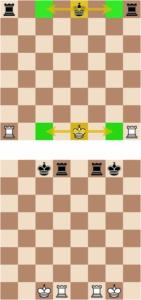
Castling
A defensive move that allows the player to safeguard the king while developing the rook.
Conditions:
- Neither the king nor the rook has been moved previously in the game.
- The squares between the king and rook must be unoccupied.
- The king is not in check, nor does it move through or into a check.
During castling, the king shifts two squares towards the rook, which then moves to the square next to the king. This maneuver accomplishes two objectives: it secures the king in a safer position, typically behind a barrier of pawns, and enhances the rook’s effectiveness, often setting it up for future moves.
En Passant
A special pawn capture occurs when an opponent’s pawn moves two squares forward from its starting position and lands adjacent to your pawn. In this case, you may capture the opponent’s pawn as if it had only moved one square forward.
This move must be performed immediately after the opponent’s move; otherwise, the right to capture en passant is lost. This unique rule prevents pawns from bypassing each other without the possibility of capture.
Pawn Promotion
When a pawn reaches the opponent’s back rank (the eighth rank for White, or the first rank for Black), it must be promoted to a queen, rook, bishop, or knight.
Typically, players promote their pawn to a queen because it is the most powerful piece on the board. However, promoting to a rook, bishop, or knight may be advantageous under specific strategic circumstances, depending on the game’s position and needs.
6. Objective of the Game
The objective of chess is to checkmate the opponent’s king, which means placing the king in a position under direct threat (check) and cannot escape. Achieving checkmate is the ultimate goal, and it concludes the game with a win for the player who delivers the checkmate.
Check and Checkmate
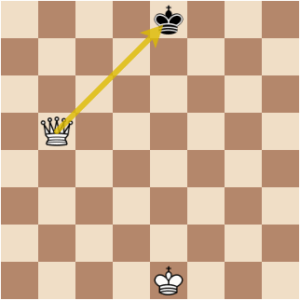
- Check: A king is in check when directly threatened by one or more of the opponent’s pieces. When a king is in check, the player must make a move to remove the threat. This can be done by moving the king to a safe square, capturing the threatening piece, or blocking the check with another piece. The game progresses toward checkmate if no legal move can be made to remove the check.
- Checkmate: Checkmate occurs when the king is in check and there are no legal moves to escape. This means the king cannot be moved to a safe square, the check cannot be blocked, and the threatening piece cannot be captured. Once checkmate is achieved, the game ends immediately, and the player whose king has been checkmated loses the game.
Stalemate and Draw Conditions
- Stalemate: A stalemate happens when a player has no legal moves left and is not in check. In other words, the player’s king is not under threat, but no other legal moves are available. This leads to a draw, where no winner is determined, and the game concludes in a tie.
Other Draws Include:
- Threefold Repetition: If the same position occurs on the board three times, with the same player to move and all pieces in the same configuration, either player can claim a draw. This prevents endless repetitions of the same positions without progress.
- 50-Move Rule: A draw can be claimed if no pawns are moved or captures are made throughout 50 consecutive moves by both players. This rule prevents the game from continuing endlessly without meaningful progress.
- Insufficient Material to Checkmate: A draw is declared if a player does not have enough pieces left on the board to deliver checkmate. For example, if one player only has a king remaining and the other has insufficient material, such as a king and a knight, checkmate is impossible, and the game is drawn.
- Mutual Agreement: Players may mutually agree to a draw at any stage of the game. This typically happens when both players recognize that neither can win due to the position on the board or lack of material. A draw by mutual agreement is a common outcome when both players are equally skilled or when a clear path to victory is no longer apparent for either side.
7. Chess Notation (Algebraic System)
Chess notation is a standardized method for recording and communicating moves during a game. The most widely used system is algebraic notation, which labels each square on the chessboard using a combination of letters and numbers. This system is essential for tracking games, studying strategies, sharing moves, and analyzing gameplay.
Each of the 64 squares on the chessboard is identified by a unique coordinate. The vertical columns (files) are labeled a to h, from left to right, from White’s perspective, and the horizontal rows (ranks) are labeled 1 to 8, from bottom to top. For example, the square in the fourth column and fourth row is labeled d4.
Piece Abbreviations:
- K: King
- Q: Queen
- R: Rook
- B: Bishop
- N: Knight (Note: “N” is used for knight to avoid confusion with king)
- Pawns: No letter is used; the destination square alone indicates a pawn move (e.g., e4 means a pawn moved to e4).
Move Notation Examples:
- Nf3: A knight moves to the f3 square.
- Qd1-d5: The queen moves from d1 to d5.
In most modern notation, the starting square is only included if needed to resolve ambiguity, so Qd5 is often sufficient unless multiple queens could move to d5.
Special notations:
- O-O: Kingside castling
- O-O-O: Queenside castling
- x: Indicates a capture (e.g., Bxe6 means bishop captures on e6)
- +: Indicates check (e.g., Qh5+)
- #: Indicates checkmate (e.g., Qh7#)
Understanding algebraic notation is key for reviewing famous matches, improving strategy, and communicating effectively in the global chess community.
8. Chess Opening Principles for Beginners
Understanding how to begin a chess game is crucial for new players. The opening sets the foundation for your entire strategy and influences how the rest of the game unfolds. Following a few time-tested opening principles can help beginners avoid early mistakes, develop strong positions, and smoothly transition into the middlegame with confidence.
- Control the center: Use pawns and pieces to occupy central squares (e4, d4, e5, d5).
Controlling the center is a cornerstone of strong opening play. By occupying or influencing central squares like e4, d4, e5, and d5, you give your pieces more room to maneuver and restrict your opponent’s options. Central control also allows for easier transitions into the middlegame and enhances tactical opportunities.
- Develop minor pieces (knights and bishops) early.
The early development of knights and bishops allows you to activate your position efficiently. Bring your knights out before your bishops, usually to c3/f3 or c6/f6. Position bishops on open or active diagonals to support your center and prepare for castling. Avoid leaving them trapped behind pawns for too long.
- Avoid moving the same piece more than once in the opening.
Repeating moves with the same piece wastes time and gives your opponent a lead in development. Focus on bringing out new pieces to build a strong, coordinated position with each move. Time is crucial in the opening, and efficiency wins tempo.
- Castle early for the king’s safety.
Castling secures your king behind a wall of pawns, bringing a rook into play. Delaying castling can expose your king to attacks, especially in open positions. Kingside castling is often safer and quicker, but queenside is also viable depending on your setup.
- Don’t move the queen too soon; she can become vulnerable.
The queen is powerful but can be easily chased away early on. Premature queen activity often results in lost tempo and tactical blunders. Allow other pieces to support development while the queen remains protected.
- Connect your rooks by clearing the back rank.
Once you develop your minor pieces and queen, your rooks should be connected on the first rank. Connected rooks support each other and are better positioned for open-file control.
9. Common Mistakes and How to Avoid Them
In chess, beginners often fall into the same traps—errors that can turn a promising game into a quick loss. Developing the ability to identify and steer clear of these common mistakes is essential for consistent improvement. By staying alert and thinking ahead, players can make more informed decisions and cultivate stronger habits. Below are some of the most frequent errors made by beginners and simple ways to avoid them:
- Ignoring opponent threats: Always evaluate your opponent’s next move.
Many players focus solely on their plans, overlooking key threats posed by their opponents. Always take a moment to understand what your opponent’s last move accomplishes. Ask yourself: “What are they attacking?” and “What will they do next?” This habit helps you avoid blunders and enhances your tactical awareness.
- Overexposing the king: Castle early to prevent attacks.
Leaving the king in the center for too long can be dangerous, especially as pieces are removed from the board. Castling places your king in a safer position behind pawns and activates your rook. Avoid opening too many pawns in front of your king unless necessary, as this can create weaknesses.
- Weak pawn structure: Avoid moving too many pawns without a plan.
Pawns are the soul of the position, but unlike pieces, they cannot retreat. Random or excessive pawn moves can lead to structural weaknesses, such as doubled pawns, isolated pawns, or open files that benefit your opponent. Aim for purposeful pawn moves that support development and control key squares.
- Trading without purpose: Evaluate whether exchanges benefit your position.
Not all trades are equal. Beginners often exchange pieces automatically, without considering the consequences. Before you capture, ask: “Who benefits from this trade?” Good trades should improve your position, increase activity, or weaken the opponent’s setup.
- Tunnel vision: Take your opponent’s ideas into account, rather than concentrating solely on your own.
Focusing only on your plans can close your eyes to the threats and opportunities created by your opponent. Always be aware of what they’re trying to achieve. A strong player balances offense with defense and stays flexible when the position changes.
10. Tips to Improve Your Chess Game
- Practice regularly with online tools and puzzles.
Consistent practice with interactive chess platforms and tactical puzzles enhances pattern recognition, sharpens calculation skills, and builds muscle memory over time.
- Study games of grandmasters.
Observing professional games helps you understand strategic concepts, master openings, and learn endgame techniques through high-level decision-making examples.
- Learn from your losses—analyze what went wrong.
Reviewing your defeats allows you to identify recurring mistakes and improve your thinking process, turning setbacks into valuable learning opportunities.
- Play longer games to develop deep thinking.
Extended time controls promote thoughtful planning and reduce impulsive moves, fostering better positional understanding and foresight.
- Use a chess coach or join a local club.
Guided instruction and peer interaction provide personalized feedback, motivation, and exposure to diverse playing styles that accelerate improvement.
11. Chess Etiquette and Fair Play
- Be respectful: Greet your opponent and offer a handshake.
Demonstrating courtesy at the start of a game sets a positive tone and shows sportsmanship, regardless of the game’s outcome.
- Don’t distract or comment during the game.
Silence and focus are essential; distractions or unsolicited remarks can break concentration and are considered impolite and unsporting.
- Touch-move rule applies in formal settings—move the piece you touch.
In rated or tournament play, once you touch a piece, you must move it if legally possible, promoting discipline and intent.
- Resign gracefully when defeated.
Acknowledging a lost position with grace honors your opponent’s skill and reflects maturity and humility in competition.
- Accept the draw offers respectfully.
Whether you accept or decline, always respond calmly and courteously, ensuring a respectful and professional atmosphere is maintained throughout the game.
12. Frequently Asked Questions (FAQs)
Q1: What’s the best way to start learning chess?
A: Begin by understanding piece movements and simple checkmates. Use chess apps or video tutorials to guide your learning.
Q2: Can I win with just a king and a queen?
A: A queen and king can checkmate an opponent’s lone king by using the correct technique.
Q3: What does “blunder” mean in chess?
A: A blunder is a significant mistake that typically results in loss of material or checkmate.
Q4: How long is a standard game of chess?
Casual games typically range from 10 to 60 minutes, whereas classical tournament games can last for several hours or more.
Q5: Should I memorize chess openings?
A: Beginners should focus on principles instead of memorization. Grasping the concepts behind openings is more valuable.
Q6: Is a draw the same as a stalemate?
A: A stalemate represents a form of draw. Yet, not every draw qualifies as a stalemate; others may arise from repetition, the 50-move rule, or mutual agreement.
13. Final Thoughts
Chess is more than just a game; it’s a battle of intellect and a test of foresight. Whether you’re new to the rules or striving to refine your skills, maintaining curiosity and consistent practice will ensure growth. Embrace the elegance of strategic play, learn from each move, and savor the journey. Every chess master started with the question, “How do I play?” With commitment, you can master the board.
Updated on May 17,2025
